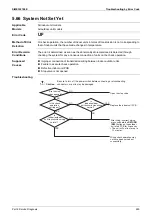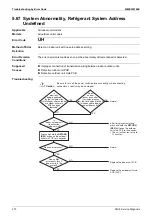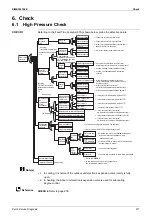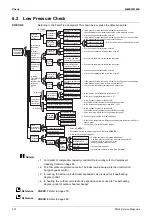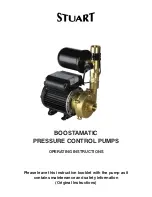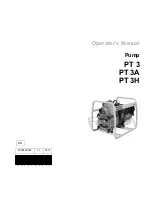
Check
SiME332106E
280
Part 6 Service Diagnosis
6.7 Vacuuming and Dehydration Procedure
CHECK 8
Conduct vacuuming and dehydration in the piping system following the procedure for Normal
vacuuming and dehydration described below.
Furthermore, if moisture may get mixed in the piping system, follow the procedure for Special
vacuuming and dehydration described below.
Normal vacuuming and dehydration
1. Vacuuming and dehydration
Use a vacuum pump that enables vacuuming up to –100.7 kPaG (5 Torr, –755 mmHgG).
Connect manifold gauges to the service ports of liquid pipe and gas pipe and run the
vacuum pump for a period of two or more hours to conduct evacuation to –100.7 kPaG or
less.
If the degree of vacuum does not reach –100.7 kPaG or less even though evacuation is
conducted for a period of two hours, moisture will have entered the system or refrigerant
leakage will have been caused. In this case, conduct evacuation for a period of another
one hour.
If the degree of vacuum does not reach –100.7 kPaG or less even though evacuation is
conducted for a period of three hours, conduct the leak tests.
2. Leaving in vacuum state
Leave the compressor at the degree of vacuum of –100.7 kPaG or less for a period of
one hour or more, and then check to be sure that the vacuum gauge reading does not
rise. (If the reading rises, moisture may have remained in the system or refrigerant
leakage may have been caused.)
3. Additional refrigerant charge
Purge air from the manifold gauge connection hoses, and then charge a necessary
amount of refrigerant.
Special vacuuming and dehydration
Use this procedure if moisture may get into the piping, such as construction during the rainy
season (dew condensation may occur, or rainwater may enter the piping during construction
work).
1. Vacuuming and dehydration
Follow the same procedure as that for Normal vacuuming and dehydration described
above.
2. Vacuum break
Pressurize with nitrogen gas up to 0.05 MPaG.
3. Vacuuming and dehydration
Conduct vacuuming and dehydration for a period of one hour or more. If the degree of
vacuum does not reach –100.7 kPaG or less even though evacuation is conducted for a
period of two hours or more, repeat vacuum break - vacuuming and dehydration.
4. Leaving in vacuum state
Leave the compressor at the degree of vacuum of –100.7 kPaG or less for a period of
one hour or more, and then check to be sure that the vacuum gauge reading does not
rise.
5. Additional refrigerant charge
Purge air from the manifold gauge connection hoses, and then charge a necessary
amount of refrigerant.




